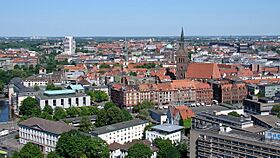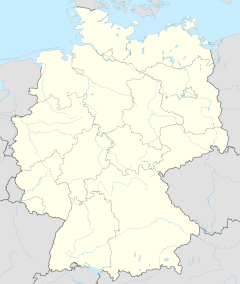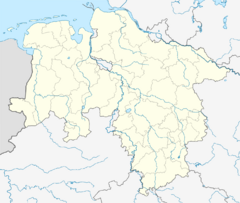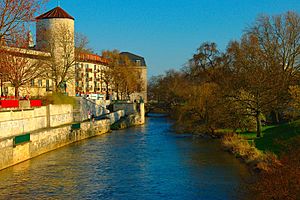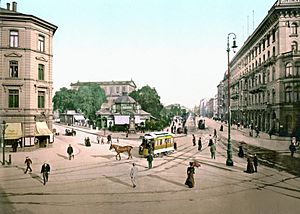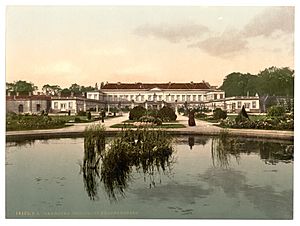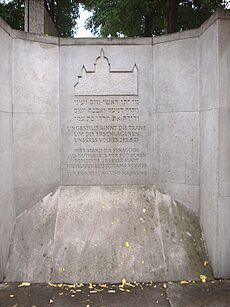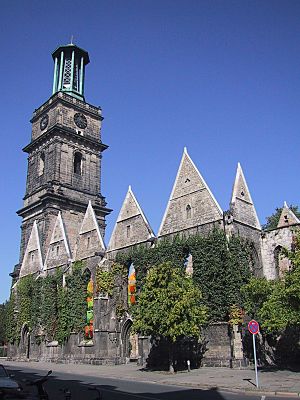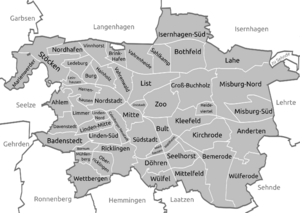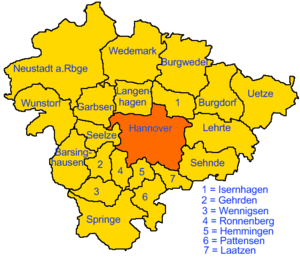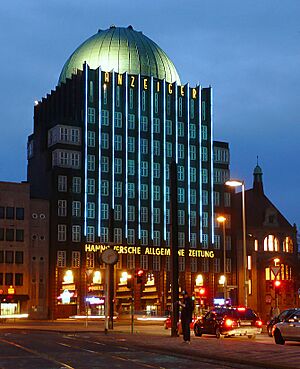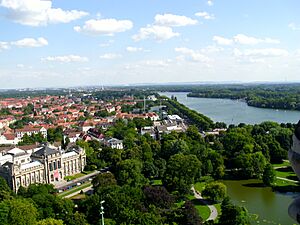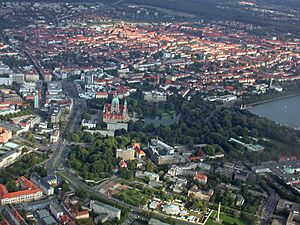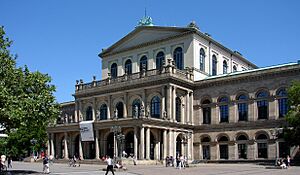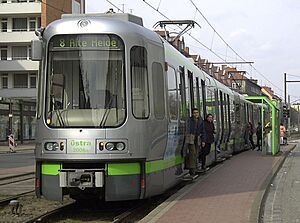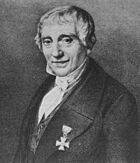Hanover facts for kids
Quick facts for kids
Hanover
|
|||
|---|---|---|---|
|
Clockwise from top: view over the city centre, Market Church of Saints George and James, New Town Hall, University of Hannover, Herrenhausen Gardens, Old Town Hall
|
|||
|
|||
|
Location of Hanover within Hanover Region district
 |
|||
| Country | Germany | ||
| State | Lower Saxony | ||
| District | Hanover Region | ||
| Subdivisions | 13 districts | ||
| Area | |||
| • City | 204.01 km2 (78.77 sq mi) | ||
| Elevation | 55 m (180 ft) | ||
| Population
(2022-12-31)
|
|||
| • City | 545,045 | ||
| • Density | 2,671.66/km2 (6,919.56/sq mi) | ||
| • Metro | 1,119,032 | ||
| Time zone | UTC+01:00 (CET) | ||
| • Summer (DST) | UTC+02:00 (CEST) | ||
| Postal codes |
30001–30669
|
||
| Dialling codes | 0511 | ||
| Vehicle registration | H | ||
Hanover (han-OH-vər-,_-han-Ə-vər; German: Hannover) is a major city in Germany. It is the capital and largest city of the German state of Lower Saxony. With over 535,000 people (in 2021), it's the 13th biggest city in Germany. It's also the fourth-largest city in northern Germany.
Hanover is an important place for travel. It has major railway lines and highways (Autobahnen) that connect different parts of Europe. Hannover Airport is one of Germany's busiest airports. The city is also home to important universities and medical schools.
Hanover is famous for its large trade fairs. These include the Hannover Fair and the CeBIT (until 2018). It also hosts the world's largest marksmen's festival, the Schützenfest Hannover, and a big Oktoberfest.
Contents
What's in a Name?
The name Hanover might come from a German phrase meaning 'on the high river bank'.
In English, the city's name used to be spelled Hanover. But now, the German spelling, Hannover (with a double 'n'), is often used. Even the city's official English websites use Hannover.
A Look at Hanover's Past
How Hanover Began

Hanover started as a small village in the Middle Ages. It was on the east bank of the River Leine. Its name, Honovere, might mean 'high river bank'. The village grew because it was a good place for trade. It was located where many paths crossed. In 1241, it became a town.
Being on the Leine River helped it grow. The river connected it to the Hanseatic League city of Bremen. Hanover was also near the Harz mountains. This made it a gateway for trade between the Low Countries and places like Saxony. In the 14th century, big churches and a city wall were built. Trade in iron and silver from the Harz Mountains also made the city more important.
Royal Connections
In 1636, George, Duke of Brunswick-Lüneburg, moved his home to Hanover. His family became Prince-Electors in 1692. This meant they had a special high rank in the Holy Roman Empire. Their land became known as the Electorate of Hanover.
From 1714 to 1837, the rulers of Hanover also became Kings of Great Britain. This was because of a "personal union." The first was George I of Great Britain. The last British king to rule Hanover was William IV of the United Kingdom. After him, a different family member became king of Hanover. This was because Hanover's rules meant a woman (like Queen Victoria) could not inherit the throne if there was a male heir.
During this time, the kings rarely visited Hanover. A Viceroy (a ruler acting for the king) managed things in Hanover.
Wars and Changes
During the Seven Years' War (1756–1763), Hanover was occupied by the French army in 1757. But it was taken back by Anglo-German forces the next year.
In 1803, Napoleon's French soldiers occupied Hanover. Many soldiers from Hanover went to Great Britain and formed the King's German Legion. This group fought against France in the Napoleonic Wars. In 1814, Hanover became a kingdom.
In 1866, Hanover became part of Prussia after the Austro-Prussian War. Hanover had its own army, but Prussia defeated it. Hanover then became the capital of the Prussian Province of Hanover.
In the late 1800s, Hanover started to get modern transport. The first horse-drawn railway opened in 1872. Electric trams started running in 1893.
The Nazi Era and World War II
After 1937, the leaders of Hanover were members of the Nazi Party. Hanover had a large Jewish community. In 1938, many Jewish people of Polish origin were forced to leave Hanover. This led to a terrible event called Kristallnacht (Night of Broken Glass) on November 9, 1938. On this night, the synagogue in Hanover was burned down by the Nazis.
In 1941, Jewish families in Hanover were forced into special areas. Many were later sent to camps. About 2,400 Jewish people from Hanover were deported, and very few survived. During the war, several camps were built in Hanover. Many people were held there, including Jewish people and prisoners from other countries. When American soldiers arrived in April 1945, fewer than 100 Jewish people were left in the city. Today, a memorial at the Opera Square remembers the Jewish people who suffered in Hanover.
Hanover was an important target during World War II. It had many railway lines, roads, and factories. The city was bombed many times by the Allies. Over 6,000 civilians died in these bombings. More than 90% of the city center was destroyed. After the war, the Aegidienkirche church was not rebuilt. Its ruins were kept as a memorial to those who died in the war. Today, about 25% of the city's buildings are from before 1950.
American troops captured Hanover on April 10, 1945.
After the War
After World War II, Hanover was in the British zone of Germany. In 1946, it became part of the new state of Lower Saxony.
Today, Hanover is a "vice-president city" for Mayors for Peace. This is a group of mayors from around the world. They work to get rid of nuclear weapons.
Hanover's Location and Weather
Climate
Hanover has an oceanic climate. This means its weather is influenced by the ocean. It doesn't have extreme hot or cold temperatures.
| Climate data for Hannover (1991–2020 normals, extremes 1936–2023) | |||||||||||||
|---|---|---|---|---|---|---|---|---|---|---|---|---|---|
| Month | Jan | Feb | Mar | Apr | May | Jun | Jul | Aug | Sep | Oct | Nov | Dec | Year |
| Record high °C (°F) | 17.0 (62.6) |
19.1 (66.4) |
24.4 (75.9) |
29.7 (85.5) |
32.2 (90.0) |
35.7 (96.3) |
39.2 (102.6) |
38.1 (100.6) |
33.0 (91.4) |
27.4 (81.3) |
20.7 (69.3) |
17.0 (62.6) |
39.2 (102.6) |
| Mean daily maximum °C (°F) | 4.4 (39.9) |
5.5 (41.9) |
9.3 (48.7) |
14.7 (58.5) |
18.6 (65.5) |
21.7 (71.1) |
23.9 (75.0) |
23.7 (74.7) |
19.4 (66.9) |
14.0 (57.2) |
8.5 (47.3) |
5.3 (41.5) |
14.1 (57.4) |
| Daily mean °C (°F) | 2.1 (35.8) |
2.6 (36.7) |
5.3 (41.5) |
9.5 (49.1) |
13.5 (56.3) |
16.6 (61.9) |
18.7 (65.7) |
18.4 (65.1) |
14.5 (58.1) |
10.2 (50.4) |
6.0 (42.8) |
3.0 (37.4) |
10.0 (50.0) |
| Mean daily minimum °C (°F) | −0.5 (31.1) |
−0.5 (31.1) |
1.3 (34.3) |
4.2 (39.6) |
7.8 (46.0) |
11.1 (52.0) |
13.3 (55.9) |
13.1 (55.6) |
9.9 (49.8) |
6.5 (43.7) |
3.2 (37.8) |
0.5 (32.9) |
5.8 (42.4) |
| Record low °C (°F) | −24.8 (−12.6) |
−24.3 (−11.7) |
−18.3 (−0.9) |
−7.4 (18.7) |
−3.2 (26.2) |
0.3 (32.5) |
3.3 (37.9) |
3.3 (37.9) |
−1.3 (29.7) |
−7.9 (17.8) |
−17.1 (1.2) |
−20.9 (−5.6) |
−24.8 (−12.6) |
| Average precipitation mm (inches) | 52.6 (2.07) |
40.5 (1.59) |
44.8 (1.76) |
35.5 (1.40) |
52.0 (2.05) |
52.7 (2.07) |
68.2 (2.69) |
65.3 (2.57) |
52.1 (2.05) |
56.7 (2.23) |
51.6 (2.03) |
54.6 (2.15) |
626.7 (24.67) |
| Average precipitation days (≥ 1.0 mm) | 17.4 | 15.5 | 15.4 | 12.6 | 13.5 | 14.0 | 15.2 | 15.0 | 13.4 | 15.5 | 17.2 | 18.3 | 183 |
| Average snowy days (≥ 1.0 cm) | 5.5 | 4.9 | 1.8 | 0.1 | 0 | 0 | 0 | 0 | 0 | 0 | 0.8 | 3.6 | 16.7 |
| Average relative humidity (%) | 84.7 | 81.4 | 76.9 | 70.1 | 70.3 | 70.8 | 71.0 | 72.2 | 78.2 | 83.0 | 86.2 | 86.0 | 77.6 |
| Mean monthly sunshine hours | 47.4 | 68.4 | 117.2 | 177.1 | 212.1 | 211.1 | 213.5 | 198.5 | 151.6 | 106.2 | 51.8 | 39.3 | 1,596.9 |
| Source 1: World Meteorological Organization | |||||||||||||
| Source 2: DWD | |||||||||||||
City Parts
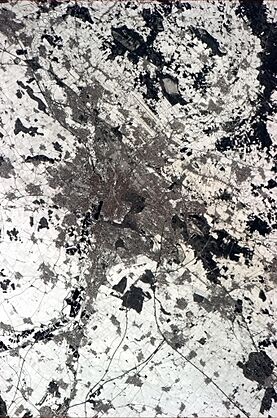
Hanover, as seen from the International Space Station.
|
Hanover is divided into 13 boroughs. These boroughs are then split into 53 smaller quarters.
Boroughs
- Mitte
- Vahrenwald-List
- Bothfeld-Vahrenheide
- Buchholz-Kleefeld
- Misburg-Anderten
- Kirchrode-Bemerode-Wülferode
- Südstadt-Bult
- Döhren-Wülfel
- Ricklingen
- Linden-Limmer
- Ahlem-Badenstedt-Davenstedt
- Herrenhausen-Stöcken
- Nord
Quarters
Some of the 53 quarters include:
- Nordstadt
- Südstadt
- Oststadt
- Zoo (for the zoo itself, see Hanover Zoo)
- Herrenhausen
- Waldheim
Fun Places to See
Hanover has many interesting places to visit. There are about 5,500 historic buildings in the city.
Royal Gardens of Herrenhausen
One of the most amazing sights is the Royal Gardens of Herrenhausen. Its Great Garden is a famous European Baroque garden. The palace there was rebuilt after being destroyed in the war. It reopened in 2013. You can see the Grotto, designed by artist Niki de Saint Phalle. The Great Garden also has Europe's tallest garden fountain.
The Berggarten is a botanical garden. It has the largest collection of orchids in Europe. You can also find a Tropical House and a Cactus House here. The Mausoleum of the Guelphs (a royal family) is also in the Berggarten. The Georgengarten is an English-style garden.
New Town Hall
Hanover's most famous building is the New Town Hall (Neues Rathaus). Inside, you can see four models of the city. An elevator takes you up to the top of the dome for great views. This elevator is special because it goes up at a unique angle.
Hanover Zoo
The Hanover Zoo is one of the best zoos in Germany. It has different themed areas like Sambesi, Meyers Farm, and Yukon Bay. You can see many animals, including gorillas and sea birds. The zoo also has a tropical house and a jungle house. In 2010, over 1.6 million people visited the zoo. There is also a Sea Life Centre Hanover, which is Germany's first tropical aquarium.
Old Town and More
The Old Town is another interesting area. Here you'll find the big Marktkirche (Market Church) and the 15th-century Old Town Hall. The Old Town Hall was damaged in World War II but was rebuilt. Nearby are historic houses and the Beguine Tower. The Kreuz-Church-Quarter has many small streets.
On the edge of the Old Town, you can find the Market Hall and the Leine Palace. The ruined Aegidien Church is now a memorial for war victims. Near the river Leine, you can see the Nanas sculptures by Niki de Saint Phalle. These are part of the Sculpture Mile.
Other popular sights include the Waterloo Column, the Opera House, the Hanover Central Station, and the Maschsee lake. Hanover has 40 parks, forests, and gardens, making it a very green city. The city forest Eilenriede is one of the largest in Europe.
The historic Leibniz Letters are kept at the Gottfried Wilhelm Leibniz Library. They are so important that they are on UNESCO's Memory of the World Register.
Hanover Fairground
The Hanover Fairground is outside the city center. It was the site of the EXPO 2000 world fair. It is the largest exhibition center in the world. It has huge indoor spaces and many halls. Some of these halls are amazing to look at. The fairground also has the Hermes Tower and the EXPO Roof, which is the largest wooden roof in the world.
In the Anderten district, you can visit the European Cheese Centre. Another sight there is the Hindenburg Lock, a very large lock built in 1928. The Tiergarten in Kirchrode is a forest that used to be for the king's hunting.
The Telemax is a 282-meter-high communications tower. It is the tallest building in Lower Saxony.
The Red Thread
To help visitors see the city, 36 important sights in the city center are connected by a 4.2-kilometer-long walking trail. It's called the Red Thread because it's literally painted onto the pavement with red paint! It starts and ends near the central train station.
People of Hanover
Hanover has about 540,000 people. It is the largest city in Lower Saxony. The wider Hanover Region has about 1.16 million people. Hanover's population grew a lot after World War II. Many people from other countries, like Turkey, Greece, and Italy, moved here. Hanover also has one of the largest Vietnamese communities in Germany. The Viên Giác pagoda in Hanover is the largest Vietnamese pagoda in Germany.
Hanover is known as a good city to live in because of its location and size.
| Nationality | Population (31 December 2022) |
|---|---|
| 15,600 | |
| 8,200 | |
| 7,300 | |
| 6,000 | |
| 5,400 | |
| 4,900 | |
| 4,300 | |
| 3,700 | |
| 3,400 | |
| 3,000 | |
| 2,800 | |
| 2,750 | |
| 2,700 | |
| 2,500 | |
| 2,350 | |
| 2,150 | |
| 2,000 | |
| 1,900 | |
| 1,850 | |
| 1,400 | |
| 1,200 |
Culture and Fun
Religious Life
Hanover is an important center for several Protestant groups. These include the World Communion of Reformed Churches and the Protestant Church in Germany.
In 2015, about 31% of people in Hanover were Protestant. About 13% were Roman Catholic. The rest had other religions or no religion.
Museums and Art
The Historisches Museum Hanover tells the story of Hanover. It shows how the city grew from a small settlement to what it is today. It also focuses on the time when Hanover was connected to the British royal family.
The Kestner-Museum shows 6,000 years of art. It has collections from ancient cultures, ancient Egypt, and old coins.
The Sprengel Museum is one of Germany's most famous art museums. It shows art from the 20th century. It has works by artists like Kurt Schwitters and Niki de Saint-Phalle.
The Wilhelm Busch Museum is special. It is the German Museum of Caricature and Critical Graphic Arts. It has many works by Wilhelm Busch and other cartoonists.
If you like astronomy, you can visit the Observatory Geschwister Herschel. There is also a small planetarium at the Bismarck School.
Theatre and Music
Hanover has about 40 theaters. The Opera House and the Schauspielhaus (Play House) are part of the Lower Saxony State Theatre. The Theater am Aegi is a main theater for musicals and shows.
Hanover is also known for its music. It has two symphony orchestras: the Lower Saxon State Orchestra Hanover and the NDR Radiophilharmonie. There are also two famous choirs: the girls' choir and the boys' choir.
Famous rock bands like Scorpions and Fury in the Slaughterhouse are from Hanover. Lena Meyer-Landrut, who won the Eurovision Song Contest 2010, is also from Hanover.
Sports
Hannover 96 is the city's main football team. They play their home games at the Niedersachsenstadion. This stadium hosted matches in the 1974 and 2006 World Cups.
The Hannover Indians are the local ice hockey team. They play at the Eisstadion am Pferdeturm.
Hanover has a strong history in rugby union. The first German rugby team was started here in 1878. Several Hanover teams play in Germany's top rugby leagues.
The city is also a hub for Water sports, especially Water polo. Clubs from Hanover have won the German championship many times. The Maschsee lake and the rivers Leine and Ihme are used for sailing, rowing, and canoeing.
The Hanover Marathon is a big running event. It has over 11,000 participants and attracts about 200,000 spectators. The International Fireworks Competition is held every year in the Great Garden.
Fun Events
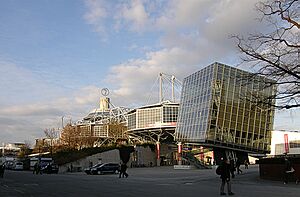
Hanover is a top city for exhibitions. It hosts over 60 international and national shows each year. Some of the most famous are the CeBIT and the Hanover Fair.
Hanover also hosts the Schützenfest Hannover. This is the world's largest marksmen's fun fair. It happens once a year in late June or early July. It has over 260 rides and food stalls. A highlight is the 12-kilometer-long Parade of the Marksmen. This is the longest parade in Europe, with over 12,000 people taking part. About 2 million people visit this fair every year.
Hanover also has one of Europe's largest spring festivals. The Oktoberfest Hanover is the second largest Oktoberfest in the world.
The Maschsee Festival takes place around the Maschsee Lake. About 2 million visitors come to enjoy live music and shows. It is the largest festival of its kind in Northern Germany.
Visiting Hanover

Hanover is a popular place for tourists. In 2021, about 580,000 people visited the city. Many came from the Netherlands and the United Kingdom. Famous sights like the New Town Hall, Herrenhausen Gardens, and Hanover Zoo attract many visitors.
The annual trade fair "Hannover Messe" is one of the world's largest trade fairs. It brings in between 100,000 and 200,000 visitors each year.
Getting Around Hanover
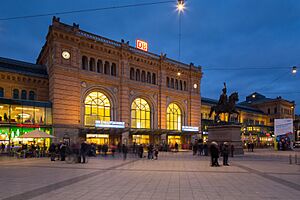
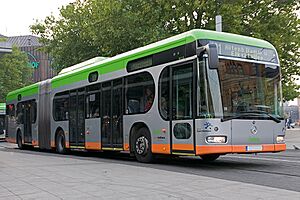
Trains
Hanover's main train station, Hanover Hauptbahnhof, is a big hub for Germany's high-speed trains. It connects to many cities in Germany and other countries.
Airport
Hannover Airport serves Hanover and the surrounding area. It is located in Langenhagen, just north of the city.
Roads
Hanover is also an important place for Germany's highway (Autobahn) network. Two major highways, the A 2 and A 7, meet at the Kreuz Hanover-Ost junction.
The city also has a system of expressways called Schnellweg. These roads help traffic move quickly around the city.
Public Transport
Hanover has a large system of trams (Stadtbahn) and buses. These are run by a company called üstra. The city uses specially designed buses and trams.
Bicycles
Bicycle paths are very common in Hanover's city center. You can even take your bike on a tram or bus during off-peak hours.
Hanover's Economy
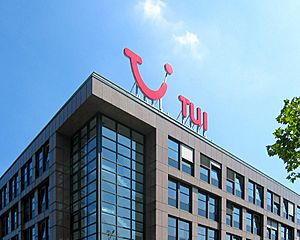
Many important businesses are located in Hanover. The Volkswagen Commercial Vehicles factory is the biggest employer in the region. It makes vans and other commercial vehicles.
Continental AG, a company that makes tires and car parts, was founded in Hanover in 1871. It is one of the city's main companies.
The audio equipment company Sennheiser and the travel group TUI AG are also based in Hanover. Many insurance companies, like Talanx and Hannover Re, have their headquarters here too.
Top Employers in Hanover
|
Employer |
est. | Hanover located employees | |
|---|---|---|---|
| Volkswagen Commercial Vehicles (VWN) | 1956 | 14,500 | |
| Klinikum Region Hannover | 2005 | 8,500 | |
| Hannover Medical School | 1961 | 7,600 | |
| Continental | 1871 | 7,500 | |
| Deutsche Bahn | 1994 | 6,000 | |
| TUI | 2002 | 4,600 | |
| DHL | 1969 | 4,400 | |
| Nord/LB | 1970 | 4,000 | |
| Talanx | 1996 | 4,000 | |
| WABCO | 2007 | 2,600 | |
| VHV Group | 2003 | 2,500 | |
Learning and Education
Hanover has several universities and schools for higher education. The Leibniz University Hannover is the largest.
Other important schools include:
- Hochschule für Musik, Theater und Medien Hannover (University of Music, Drama and Media)
- Hannover Medical School (a leading medical school)
- School of Veterinary Medicine Hanover
- GISMA Business School
- Hochschule Hannover (University of Applied Sciences and Arts)
The Schulbiologiezentrum Hannover has practical biology schools. The University of Veterinary Medicine Hanover also has a special botanical garden. It focuses on medicinal and poisonous plants.
Famous People from Hanover

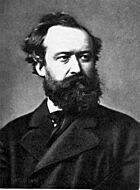



Many notable people were born or lived in Hanover:
- Hannah Arendt (1906–1975), a political thinker.
- Emil Berliner (1851–1929), who invented the phonograph.
- Walter Bruch (1908–1990), who invented the PAL color television system.
- Wilhelm Busch (1832–1908), a famous caricaturist and poet.
- George I (1660–1727), a King of Great Britain and Hanover.
- Gottfried Wilhelm Leibniz (1646–1716), a brilliant philosopher and mathematician.
- Klaus Meine (born 1948), the lead singer of the band Scorpions.
- Lena Meyer-Landrut (born 1991), who won the Eurovision Song Contest 2010.
- Per Mertesacker (born 1984), a well-known footballer.
- Niki de Saint Phalle (1930–2002), a famous sculptor and painter.
- Gerhard Schröder (born 1944), a former Chancellor of Germany.
- Kurt Schwitters (1887–1948), an artist.
- Christian Wulff (born 1959), a former President of Germany.
Sister Cities
Hanover has "sister city" relationships with several cities around the world. This means they share culture and ideas.
Hanover also works closely with:
 Mykolaiv, Ukraine (2022)
Mykolaiv, Ukraine (2022)
See also
 In Spanish: Hannover para niños
In Spanish: Hannover para niños


